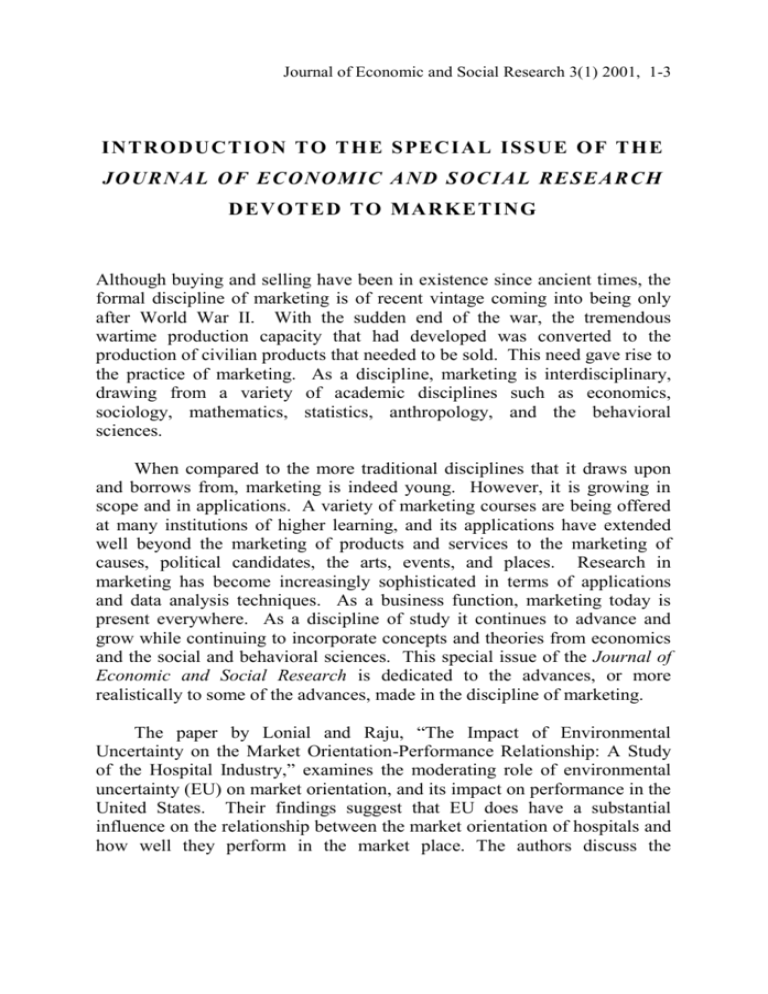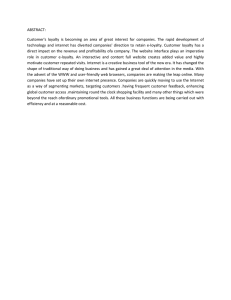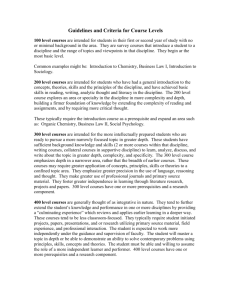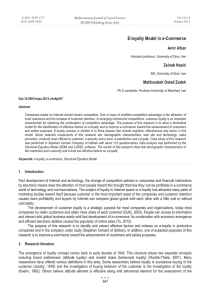INTRODUCTION TO SPECIAL ISSUE OF THE JOURNAL OF
advertisement

Journal of Economic and Social Research 3(1) 2001, 1-3 I NT RO DUCT IO N T O T H E S PE CIAL IS S UE O F T H E JOUR NA L OF E C ONOMIC A ND S OC IA L R E S EA R CH DE VO T E D T O MARKE T ING Although buying and selling have been in existence since ancient times, the formal discipline of marketing is of recent vintage coming into being only after World War II. With the sudden end of the war, the tremendous wartime production capacity that had developed was converted to the production of civilian products that needed to be sold. This need gave rise to the practice of marketing. As a discipline, marketing is interdisciplinary, drawing from a variety of academic disciplines such as economics, sociology, mathematics, statistics, anthropology, and the behavioral sciences. When compared to the more traditional disciplines that it draws upon and borrows from, marketing is indeed young. However, it is growing in scope and in applications. A variety of marketing courses are being offered at many institutions of higher learning, and its applications have extended well beyond the marketing of products and services to the marketing of causes, political candidates, the arts, events, and places. Research in marketing has become increasingly sophisticated in terms of applications and data analysis techniques. As a business function, marketing today is present everywhere. As a discipline of study it continues to advance and grow while continuing to incorporate concepts and theories from economics and the social and behavioral sciences. This special issue of the Journal of Economic and Social Research is dedicated to the advances, or more realistically to some of the advances, made in the discipline of marketing. The paper by Lonial and Raju, “The Impact of Environmental Uncertainty on the Market Orientation-Performance Relationship: A Study of the Hospital Industry,” examines the moderating role of environmental uncertainty (EU) on market orientation, and its impact on performance in the United States. Their findings suggest that EU does have a substantial influence on the relationship between the market orientation of hospitals and how well they perform in the market place. The authors discuss the 2 Introduction to the Special Issue implications of these findings for the hospital industry and for future research. The article by Van Auken, “Resources and Relationships: New Drivers of Marketing Thought,” discusses the role of resources in developing comparative advantage and how collaborative relationships promote resource advantage. In addition, it draws attention to the role of strategically defined relationship marketing as a means of creating superior value at lower costs. The paper by Menezes and Chandra, “Applications of Multivariate Analysis in International Tourism Research: A NTO's Marketing Strategy Perspective,” provides a perspective on the phenomenal growth of international tourism, the marketing role of National Tourism Organizations (NTOs), and the use of the multivariate analysis techniques most appropriate to the variety of marketing research studies that can be undertaken by NTOs. This article is of particular relevance to NTOs interested in using marketing research and multivariate techniques in developing marketing strategies for their destinations. The article by Gommans, Krishnan, and Scheffold, “From Brand Loyalty to E-Loyalty: A Conceptual Framework,” addresses a subject brought to the forefront by the rapid growth of E-Commerce and on-line shopping. The phenomenon of brand loyalty has received a great deal of attention in marketing literature. However, its counterpart in E-Commerce, namely E-Loyalty is an area of thought and research that is just emerging. This article brings together previous research in the domain of brand loyalty to postulate a conceptual framework that attempts to explain E-Loyalty. The conceptual framework is also extrapolated to the practice of E-Marketing. Given the phenomenal growth of the Internet and the resulting explosion of on-line shopping, this is a timely article. The relationship between price and quality is what drives value. The last paper by Faulds and Lonial, “Price-Quality Relationships of Nondurable Consumer Products: A European and United States Perspective,” extends the boundaries of price-quality research and the related literature to a playing field that is international. The study focuses on the price-quality relationships for food and beverages, health and beauty aids, and household items in Belgium, France, Germany, the Netherlands, and the United States. Discovered was that the price-quality relationships are low for these Introduction to the Special Issue 3 products for all of the four European countries studied, a finding similar to the results for the United States. Undoubtedly, economics as well as social, behavioral, and political environments influence a variety of marketing practices. Conversely, the economic performance of organizations, places, and even regions is influenced by the efficiency of their marketing strategies. It is hoped that this special issue of the Journal of Economic and Social Research will prompt additional discussion, interest, and research in areas of marketing that relate to the subject matter of economic and social research. Guest Editor Subhash C. Lonial











